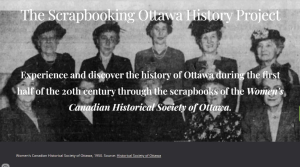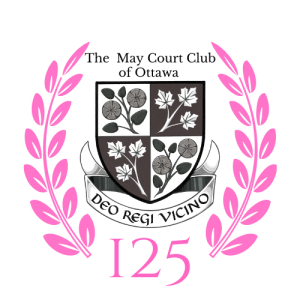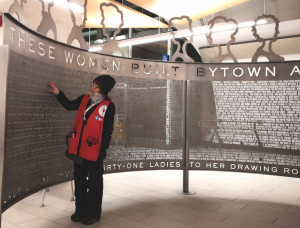The Story of Us - The History of the Women’s Canadian Historical Society of Ottawa
On the evening of Wednesday, October 9, 2024, the Historical Society of Ottawa delved into its own past with an exploration of the early decades of the Women’s Canadian Historical Society of Ottawa (WCHSO) and the remarkable women who formed and ran it. We were pleased to again welcome Connie Wren-Gunn, who reprised the session she had presented at our 125th Birthday Bash in the summer of 2023. Connie is a professional historian, being the Director, Content & Interpretative Products for Know History. She holds an M.A. in History from Carleton University and is an accomplished writer and passionate researcher.
Connie explained that the women who founded the WCHSO were primarily women of privilege, from prominent local families, who were also responsible for the formation and operation of many other organizations and charities within Ottawa. Women had few rights in the late 1890s, and a number of organizations were created by women, such as the National Council of Women and the International Order of the Daughters of the Empire, which were focused on improving the position of women in society. Although a number of working women were involved in the formation of the WCHSO, they did not remain active with the organization for long. This may be due, in part, to the WCHSO holding its meetings on weekday afternoons.
Connie pointed out that the women who formed the WCHSO were trailblazers, giving women a voice they had never had before. Although some 20 Historical Societies were formed in Canada between 1869 and 1900, the WCHSO was the only one formed and managed entirely by women. It was also the first Canadian Historical Society to send a delegate to the annual meeting of the American Historical Association, Jenny Simpson, in 1909.
Connie then gave us the story of the founding of the WCHSO starting from June, 1898 when thirty-one women met at the home of Matilda Edgar, the wife of the Speaker of the House of Commons. Their goal was to promote and preserve the history of Ottawa through publications and through the collection of artifacts. This collection eventually grew into the Bytown Museum, which opened in October 1917. The WCHSO was run as a formal organization, with a constitution, bylaws, officers with assigned responsibilities, scheduled meetings and a membership fee, initially 50 cents yearly, which was not raised until the 1930s. They also published a detailed annual report, which they began after about a decade of operation. The formality of the organization was an important point, as they realized that it would be too easy for them to be perceived simply as a group of ladies, sitting around, sipping tea and chatting. They were serious in what they were doing and wanted everyone to understand it.
Connie went on to describe some of the activities undertaken by the WCHSO in their early years. These included fundraising, money always being in short supply, the creation of scrapbooks based on local news clippings, see the link below, the staging of two major exhibitions of local artifacts and the lobbying of governments for the preservation of historic sites and the creation of plaques and monuments to honour significant events, such as Confederation, and individuals, chief among these being Lieutenant-Colonel John By.
She then told us a bit about Transactions, a journal published by the WCHSO, which consisted of 10 volumes appearing between 1901 and 1928, which contained over 130 essays. Most of these papers were written by WCHSO members, and although some were based on archival documents, most were based on previously published books, or recorded the memories of local families. Much of the focus of the papers was on early life in Bytown and the Ottawa valley, reflecting the hardships faced and overcome by the early settlers.
Connie explained that in the early part of the 20th century, universities began introducing mandatory methodologies for historical research for their graduate students requiring original research based solely on written archival documents. This professionalization of history discounted the work of passionate amateurs, such as the women of the WCHSO. Perhaps in response to the growing criticism from professional historians, the WCHSO modified their content of Transactions, reducing them in size and increasing the number of articles written by men. Connie pointed out that in the volume published in 1922, seven of the ten articles were written by men. The WCHSO, perhaps as a further response, shifted its focus away from its writings to the collection and preservation of artifacts in the Bytown Museum.
In 1956 the Women’s Canadian Historical Society of Ottawa became simply the Historical Society of Ottawa.
A full recording of Connie’s session can be viewed at: The Story of Us - The (Women's Canadian) Historical Society of Ottawa Est. 1898.
Connie’s Master’s Thesis can be read in full at: Etd | The Women's Canadian Historical Society of Ottawa: Constructing Public Memory and Preserving History in a Changing City, 1898-1932 | ID: j67314577 | Hyrax
The work performed by the 4th year Digital History class of the University of Ottawa on the scrapbooks created by the WCHSO can be viewed at: Ottawa U Scrapbooking Ottawa History - The Historical Society of Ottawa
The Historical Society of Ottawa has a page on its website dedicated to the WCHSO, which can be viewed at: WCHSO - The Historical Society of Ottawa
Ottawa U Scrapbooking Ottawa History
On the morning of December 2nd, 2024, eight members of the Historical Society of Ottawa attended the final presentation of the HIS4135 Canadian Digital History Course at the University of Ottawa, The class had taken on the project of digitizing several of the scrapbooks created by our founders, the Women’s Canadian Historical Society of Ottawa, (WCHSO), during the first half of the 20th Century. The students would then conduct some analysis of the contents of the scrapbooks. Their professor, Sarah Templier, explained that this project had been intended for a few years previous, but the pandemic shutdown access to the City of Ottawa Archives and so to the scrapbooks. She went on to explain that scrapbooks were selected, in part, on their completeness. Scrapbooks that contained a lot of loose articles just stuck between the pages were not used as they would have required a lot more work to assemble them prior to digitization. There were other scrapbooks, created by individuals and donated to the WCHSO, but these were not investigated, the research being restricted to what the WCHSO, as an organization, selected. Five full scrapbooks were however digitized and are now available online for the first time.
The class was divided into teams of three students, each focussed on a different theme, and not all working with the same digitized scrapbooks. The themes investigated were: Arts and Culture, Prominent People, Women in Sport, Women in the Public Sphere and Military History. There were some general observations common to most groups despite their specific research areas. Many commented that it was interesting to see what each scrapbooker felt was worth preserving. Equally interesting was what was “missing” from the scrapbook. They could not determine if those items we would deem today as “missing” were not collected because they were not covered by the local newspapers at that time, were not considered to be of sufficient significance or not of interest to that particular scrapbooker. It was also noted that although the scrapbooks were generally in date order, there were also cases where it seemed that articles had been placed onto pages where they would fit so as not to waste the space. Many of the scrapbookers dated their items, but the exact source was seldom preserved.. There seems to have been little collected on what we would now call marginalized communities or immigrant communities. The identification of women proved a constant frustration as, in that period, married women were identified as “Mrs. Someone”, with the resulting loss of connection to their former families and accomplishments. All groups displayed their project web pages and discussed how they had integrated additional research, such as photos, videos or sound recordings to enhance the experience of the viewer, and how they had incorporated maps, word clouds and juxta positioning of findings to produce the same effect.
The Arts and Culture team noted that, despite the lack of government funding, there was a lot of activity in and interest in the cultural landscape of Ottawa. There was also a more diverse population represented in the scrapbooks, including frequent references to Jewish theatre. A map of cultural venues was displayed. Also of interest were a number of famous individuals in the field, especially Yousuf Karsh, who were featured.
The Prominent People team discovered that while some people who garner significant mention in the scrapbooks are still well known today, such as Thomas D’Arcy McGee, others are virtually unknown to the digital world. They also found that the scrapbooker held the power to preserve an individual through their collection. As such, relatives and friends of the scrapbooker achieved a higher level of prominence than we might now attribute to them.
The Women in Sport team noted that there were certain sports that society deemed appropriate for women and that it was understood that women should participate in these sports in an appropriate manner. Thus while words such as “strong” and “powerful” would be used to describe male athletes, words such as “graceful” and “elegant” would be used to describe female athletes. The team also revealed the disparity of opportunity afforded to men and women interested in sport. The achievements of Barbara Ann Scott were well covered in the scrapbooks.
The Women in the Public Sphere team looked into where women achieved positions of leadership in the community and how this was reflected in the scrapbooks. Much of this happened in volunteer organizations and Women’s Clubs, such as our own WCHSO. Religious organizations, such as the Catholic Women’s League offered other options. The team highlighted the work of women in the Canadian Red Cross, contrasting their limited role during the First World War, doing fundraising and knitting in Canada, to their more evolved role during the Second World War, which saw women serving in large numbers overseas. The team also noted that the rise of women was not always well received.
The Military History team focussed on three time periods. Scrapbook 2 was primarily focussed on the period immediately following the First World War. The WCHSO scrapbookers collected stories related to demobilization and returning soldiers. Special interest in the 38th Battalion was noted. A few years of the interwar period, 1934/35 and 1937 were remarkable for the almost total lack of information related to the Canadian military, apart from the annual Armistice Day commemoration. This accurately reflected the state of military affairs in Canada at the time. Scrapbook 5 covered the period of 1940/41 and was dominated by the military build-up in Canada and a growing spirit of patriotism and support for the Crown.
The culmination of their project work, along with the five scanned scrapbooks, is now available to the public and can be viewed at: Scrapbooking Ottawa History or to enter into your browser: https://sites.google.com/view/scrapbookingottawahistory/home
The Historical Society of Ottawa would like to thank and congratulate the students for the work they have undertaken on our behalf to make this material more accessible to researchers. One student did caution that although the .pdf versions of the scrapbooks are searchable using Optical Character Recognition (OCR) software tools, these tools are not 100% reliable and may miss occurrences of the text string being searched for.
As a gesture of our appreciation, we will be giving Sarah Templier and each of her students: Gina Aiello, Anthony "Tony" Butticci, Daniel Cantin, Asia Csabi, Kristine Feria, Chenxuan Fu, Émilie Hollingsworth, Malcolm La Prairie, Caleb Ka Yu Lee, Noah Louden, Brennan Macey, Anthony Martimbeault, Emma Penwell, Isabelle Schneider and Ethan Stitt, a one year complimentary membership to the Historical Society of Ottawa. We hope to see you all at our events for many years to come.
The May Court Club of Ottawa Celebrates 125 Years & The Bytown Museum Opens for the 2023 Season
Our final in-person speaker session of the year, hosted by the Main Branch of the Ottawa Public Library on May 10th 2023, featured presentations from two organizations with whom we have some past connections.
Grant Vogl has been with the Bytown Museum since 2010 and is now the Senior Manager, Collections and Exhibitions. He spoke to us about the changes that have taken place at the museum over the last couple of years and their upcoming season.
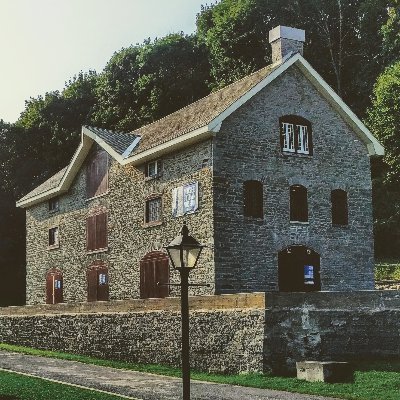 Bytown Museum Grant explained that, like most organizations, the pandemic disrupted the plans of the Bytown Museum. Closed for their 2020 and 2021 seasons, they opened for a shortened 7 week season in 2022 and were pleased to welcome some 12,000 visitors to the museum. They are very excited to be opening this Friday, May 12, 2023 for a full season. Though mostly out of the public view, much was done behind those closed doors. Grant described the work undertaken by the museum toward Reconciliation. Working with the Algonquin communities of Kigitan Zibi and Pikwakanagan, the museum reviewed their exhibits to ensure that Indigenous perspectives are included. It is important to the museum that visitors with an Indigenous heritage see themselves, their symbols, their culture and their language represented in the displays. As such, the museum has a new mural created by Indigenous artists and has 31 new tri-lingual information panels carrying English, French, and Algonquin language explanations.
Bytown Museum Grant explained that, like most organizations, the pandemic disrupted the plans of the Bytown Museum. Closed for their 2020 and 2021 seasons, they opened for a shortened 7 week season in 2022 and were pleased to welcome some 12,000 visitors to the museum. They are very excited to be opening this Friday, May 12, 2023 for a full season. Though mostly out of the public view, much was done behind those closed doors. Grant described the work undertaken by the museum toward Reconciliation. Working with the Algonquin communities of Kigitan Zibi and Pikwakanagan, the museum reviewed their exhibits to ensure that Indigenous perspectives are included. It is important to the museum that visitors with an Indigenous heritage see themselves, their symbols, their culture and their language represented in the displays. As such, the museum has a new mural created by Indigenous artists and has 31 new tri-lingual information panels carrying English, French, and Algonquin language explanations.
Grant also gave us a “sneak peak” into their 2023 season. The Community Gallery hosts an exhibit by artists Gary Blundell and Victoria Ward entitled “Sourcing the Canal”. The exhibit highlights the natural and human landscapes that have been created by resource development whose resources would very likely have travelled through the Ottawa River and the canal. The temporary gallery features an exhibit entitled “City in Flames: Ten Fires that (Re)shaped Ottawa “. Grant explained that Ottawa’s history and landscape have been shaped and re-shaped by fire. Prominent buildings, industrial areas, landmark businesses, homes, and indeed entire neighbourhoods have all fallen victim to flames. These destructive fires not only devastated, but also renewed, allowing for architectural growth, the evolution of the cityscape, new iconic tourism locales, the passing of new laws, and more.
The Bytown Museum and the Historical Society of Ottawa share a common ancestry, both starting by the Women’s Canadian Historical Society of Ottawa. Grant reminded us that the Bytown Museum still recognises this shared heritage by offering free admission to Historical Society of Ottawa members.
To learn more about the Bytown Museum and their 2023 season, please visit their website: bytownmuseum.ca.
We were then pleased to be joined by Donna Shields-Poë, the President of the May Court Club of Ottawa, who introduced their Past President, Nancy Pyper. Nancy is one of those who has spent her life volunteering at whatever was needed, where ever she was, having been almost everywhere across the country as a military wife. She joined the May Court Club of Ottawa in 2013 and soon found herself drafted into leadership roles with them. She started her talk by giving us some background on their founder.
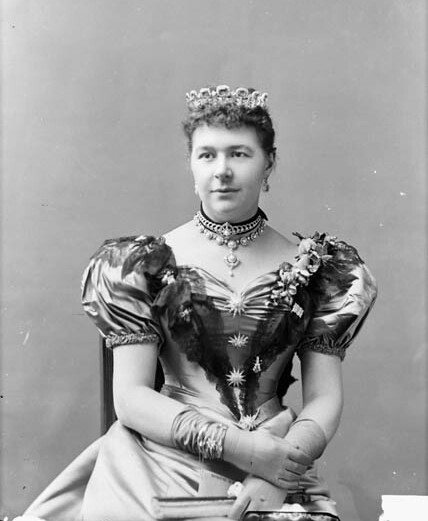 Lady Aberdeen (née Ishbel Marjorbanks) - Topley Studio / Library and Archives Canada / PA-025771Ishbel Maria Hamilton-Gordon, Marchioness of Aberdeen and Temair, GBE, was a truly remarkable person. She had been a social activist in England and Scotland promoting education, health care and women’s suffrage. So when Lady Aberdeen, who also became the Patron to the WCHSO, came to Canada in 1893 as the wife of the Governor-General and discovered that there was no social safety net or supports for women, founded the National Council of Women of Canada, the Victorian Order of Nurses and on April 30, 1898, held an elaborate garden party at Rideau Hall to which she invited young women of prominent families and challenged them to use their time and skills to provide service to those less fortunate. Thus a May Queen was crowned, her Court established, becoming the May Court Club of Ottawa, the oldest women’s service club in Canada. The May Court Club of Ottawa is one of nine now operating in Ontario.
Lady Aberdeen (née Ishbel Marjorbanks) - Topley Studio / Library and Archives Canada / PA-025771Ishbel Maria Hamilton-Gordon, Marchioness of Aberdeen and Temair, GBE, was a truly remarkable person. She had been a social activist in England and Scotland promoting education, health care and women’s suffrage. So when Lady Aberdeen, who also became the Patron to the WCHSO, came to Canada in 1893 as the wife of the Governor-General and discovered that there was no social safety net or supports for women, founded the National Council of Women of Canada, the Victorian Order of Nurses and on April 30, 1898, held an elaborate garden party at Rideau Hall to which she invited young women of prominent families and challenged them to use their time and skills to provide service to those less fortunate. Thus a May Queen was crowned, her Court established, becoming the May Court Club of Ottawa, the oldest women’s service club in Canada. The May Court Club of Ottawa is one of nine now operating in Ontario.
Lady Aberdeen’s call to the young ladies of leisure to do good works was taken up then and has been equally well responded to by subsequent generations of Ottawa women. Nancy shared that there has been a transition, as the world has changed, from single women, an initial requirement for membership, to (still only) women who are now mainly retired. This has in no way dampened their enthusiasm or commitment, their most senior member, now with 66 years of service to our community, at age 93, still does her weekly shift in the Bargain Box nearly-new store. Their motto, “Enriching the lives of others as well as our own”, is clearly heartfelt and heeded.
Nancy explained that the Club has always focused their services on women, children, and the disabled and told us some of what they have done in their century and a quarter of service to the families of Ottawa. These include support to the Victorian Order of Nurses, help in and funding for hospitals, creation of an early lending library for hospital patients (now at the Civic Campus but still closed due to Covid), help to the Red Cross, operation of one of the first (1905) Tuberculosis clinics and the creation, expansion, and operation of a Convalescence Home. Doing things “The May Court way” has allowed the Club to continue to support the families in our city and the many new Canadians who now make their homes with us.
Knitting has always been a major activity of the May Court Club. Nancy told us that this continues today with items being made for sale at artisan festivals, or items such as tuques for preemies or hats for cancer patients made and given as needed. She said that during the two World Wars the Club knitted thousands of pairs of socks for our soldiers, sailors and airmen, as well as cutting fabric and doing much other work for the war effort.
Nancy explained that some confusion exists in the mind of the public between “The May Court Club of Ottawa” and “The Hospice at May Court”. When the Club closed their Convalescents Home, in 1997 after 80 years of operation, they looked for another use for their building. The outcome was a partnership between the Club and All Saints, (now Hospice Care Ottawa); the Club provides the building, looks after maintenance etc. and makes an annual donation of $100,000, but does not actually operate the Hospice. Club members do, however, volunteer their time providing some administrative and other support services.
Traditionally, with the exception of the two World Wars, the Club funded their activities through balls, galas, vaudeville shows and other social events, which were attended by Ottawa’s leading citizens. Times change and now the Bargain Box, which has been open on Laurier Avenue East for 50 years, is the major source of their funds. It survived all the closures and restrictions of the pandemic and is well supported by the local community, especially the students at the University of Ottawa, who appreciate the quality and love the prices.
Like HSO, the May Court Club of Ottawa is celebrating their 125th anniversary this spring. To mark the occasion the Club has just announced a donation of $125,000 to the Crossroads Children’s Mental Health Centre. A wonderful gift from an organization that has certainly more than net the challenge laid down to them by Lady Aberdeen all those years ago.
To learn more about the May Court Club of Ottawa, please visit their Facebook page at maycourtclubottawa or their website at maycourt.org.
WCHSO Documents
WCSHO Scrapbooks
Check out the Ottawa University project that digitized and analyzed selected scrapbooks from the Women's Canadian Historical Society of Ottawa: Scrapbooking Ottawa Historytemporarily unavailableScrapbooking Ottawa History.
Annual Reports
Several years of annual reports from the Women’s Canadian Historical Society of Ottawa (WCHSO), the precursor to the Historical Society of Ottawa, are available via the Internet Archive:
Women’s Canadian Historical Society of Ottawa: Annual Report 1910-11
Women’s Canadian Historical Society of Ottawa: Annual Report 1913-14
Women’s Canadian Historical Society of Ottawa: Annual Report 1914-15
Women’s Canadian Historical Society of Ottawa: Annual Report 1915-16
Women’s Canadian Historical Society of Ottawa: Annual Report 1916-17
Women’s Canadian Historical Society of Ottawa: Annual Report 1917-18
Women’s Canadian Historical Society of Ottawa: Annual Report 1918-19
Women’s Canadian Historical Society of Ottawa: Annual Report 1919-20
Women’s Canadian Historical Society of Ottawa: Annual Report 1920-21
Women’s Canadian Historical Society of Ottawa: Annual Report 1921-22
Thesis
In 2016, Connie Gunn wrote an incisive thesis regarding the WCHSO’s early decades. In her paper, Gunn credited the diligence of our early members in creating a personal, nuanced and meaningful depiction of our area’s history.
Gunn also noted how the fact that our early members were drawn from the elite, often with ancestral ties to the area, inevitably shaped their interpretation of history.
Empire and colonial society were frequently revered and romanticized. Clearly, certain issues (such as the residential school system, with which some of their husbands were closely connected) might have been worthy of greater attention.
As the first few decades passed, Gunn noted the eventual diversification of the WCHSO’s membership, and also a diversification of the Society’s storytelling, including more emphasis on some of the women of history.
See this link to view the full text of Connie Gunn’s detailed study of the contributions as well as shortfalls of our well intentioned founders and early members:
Transactions of the Women’s Canadian Historical Society of Ottawa
Transactions of the Women’s Canadian Historical Society of Ottawa - by Emma Kent
Between 1901 and 1928, ten volumes of articles or transcripts of talks presented at Women's Canadian Historical Society of Ottawa meetings were published under the series of 'Transactions’. According to the AGM reports the first 8 volumes appear to have titles and themes with this practice being dropped for the last few volumes. A reprint of Volume One was issued after Volumes Six and Seven. Under the presidency of Margaret Wilson, an eleventh volume was published in 1954.
Currently, we only have a few volumes that cannot scan the entries without destroying our copies. Still, for those interested in using the articles for research, here is a list of what each volume contains, any notes added by the Society, and we could provide photos of the article’s text upon request.
Volume One - “Early History of Ottawa and Counties”
Volume Two - “The Water Ways of Canada”
Volume Three - “ Early History of Ottawa and Hull”
Volume Four - “Early History of Townships, etc.”
Volume Five - “The Battlegrounds of Canada” - 1912 - Printed in Ottawa by The Esdale Press, Limited. C or Kent and Sparks Sts. Engravers, Printers ETC.
Page 5 - The Plains of Abraham by Mrs. Wilfred Campbell.
Paper read before the Women’s Canadian Historical Society of Ottawa, February 9th, 1912.
Page 19 - The Battlegrounds of Niagara Peninsula by Mrs. Thomas Ahearn
Paper read before the Women’s Canadian Historical Society of Ottawa, November 1909.
Page 37 - Battle of the Windmill, 1838 by Miss Amey Horsey
Paper read before the Women’s Canadian Historical Society of Ottawa,
Page 43 - Battles of St. Denis and St. Charles by Miss Kathleen O’Gara
Paper read before the Women’s Canadian Historical Society of Ottawa, January 14th, 1910.
Page 51 - Siege of the Long Sault by Miss Magdalen Casey
Paper read before the Women’s Canadian Historical Society of Ottawa, February 10th, 1911.
Page 61 - Battlegrounds of the North-West Rebellions by A.E. Attwood
Paper read before the Women’s Canadian Historical Society of Ottawa, December 9th, 1910
Page 71- The Heroine of Vercheres by Mrs. Walter Armstrong
Paper read before the Women’s Canadian Historical Society of Ottawa, January 13th, 1911.
Page 80 - Madame de la Tour by Miss M. A. Northwood
Paper read before the Women’s Canadian Historical Society of Ottawa, January 12th, 1912.
Page 89 - Louisburg - its two Sieges by Miss Eva G. Read.
Paper read before the Women’s Canadian Historical Society of Ottawa, March 8th, 1913.
Page 96 - The Hero of Chateauguay by Madame S. Lelievre
Paper read before the Women’s Canadian Historical Society of Ottawa, March 12, 1909.
Volume Six - “Treaties Relating to Canada, 1632 - 1872” - Printed in 1915
Page 5 - Forward on the General Subject of Treaties.
Being the Introduction to Mrs, Bayly’s Paper on “The Treaty of Paris,” the first of the series as arranged to be given before the Society.
Page 11 - St. Germain-en-Laye.
A Treaty between Lewis XIII King of France and Charles I King of Great Britain the Restitution of New France, Acadis and Canada, and the Ships and Merchandises taken on Both Sides, March 29, 1632.
Page 25 - The Treaty of Breda (1667) - Rysmick (1697)
(Page 25) Treaty of Ryswick, 1687.
(Page 31) Treaty of Ryswick, 1697.
(Page 37) Treaty of Breda, 1667.
(Page 38) Treaty of Ryswick, 1697.
Page 40 - Treaty of Utrecht by Cordelie E. Rheaume given on March 12th, 1915.
Page 46 - Treaty of Aix-la-Chapelle, 1748. By Alice B. Lelievre .
Page 52 - The Treaty of Paris, 1763 by E.D. Bayly.
Page 62 - Treaty of Versailles, 1783 by Jenny Russell Simpsom
Page 73 - Treaty of Ghent by Muriel G. Shortt. Given on Dec 12th, 1913.
Page 84 - The Ashburton Treaty by Hazel Biggar given in January, 1914.
Page 92 - Treaty of Washington, 1871 by Edith M. McLean given on March 14, 1913.
Page 104 - Reciprocity Treaty of 1854 by Agnes M. Davis given on February 13th, 1914.
Page 113- Some Confederation Reminiscences of the Hon. Senator Costigan by his daughter Teresa Contigan Armstrong Given on March 10th, 1914.
Reprint of Volume One
Volume Seven - “Historical Collection”
Page 5 - Reminiscences of Bytown by Mrs. Jenny Russell Simpson
Read before the WCHSO on Feb 11th, 1916.
Page 12 - Toronto University by Helen McLean of 292 Daly Ave, Ottawa
Read before the WCHSO on March 10th, 1916.
Page 16 - The Settlement of the Country of Lennox and Addington by Mrs. Annie Rothwell Christie
Page 26 - My Native County - Glengarry by Mary Gerenish H. Foran - December 10th, 1915
Page 38 - The Cairn by Mary Masson
Page 42 - Nova Scotia by Alberta T. Somerville
Page 59 - The History of Canada in Sixty Lines by T. Chisholm, M.D., ex-MP and read before the WCHSO by Mrs. Simpson, Nov 10, 1917.
Volume Eight - “Personal Recollections of Bytown and Early Ottawa”
Page 5 - Philemon Wright and the Settlement of Hull by Hon. Justice Latchford.
Read February, 1921 before the WCHSO.
Page 20 - Notes on some of the Prominent Citizens of the Early Days of Bytown by Leopoldine Beauchamp Pigeon.
Page 23- Bytown to Ottawa, 1827- 1877 by William Pittman Lett.
Short Panoramic View of Ottawa History, Written in its Jubilee Year by William Pittman Lett, City Clerk.
Page 34 - Reminiscences - How Peace was Preserved in the Days Gone by.
This paper, read some years ago before the Perth Historical Society, has been presented to the WCHSO by Miss Clara B. Armstrong, Perth, Ont.
Page 38 - Bytown in 1837. By H. P. Hill
Page 52 - Bytown Election of 1841 by H.P. Hill
Page 63 - Memories of Bytown by W.H. Cluff - January 1920.
Our First Telegraph Line (page 68)
Road from Upper Town to Lower Town (page 69)
Freight and Passengers in the Old Days (page 72)
The Military Graveyard (page 74)
The High Cost of Living in the 1840’s and 50’s (page 74)
When the Spark Estate was put on the Market (page 75)
Page 77 - History of The Ottawa Fire Department - Showing its development with the Growth of the city, from its Earliest Volunteer Organization up to the Present Time by John W. Graham, Chief Fire Department.
Page 89 - A Glimpse of the Capital in 1849 by Marion Jamieson
Page 94 - On Early Patents for Inventions Granted to the Residents of Ottawa by William J. Lynch, I.S.O., Chief of the Canadian Patent Office.
Volume Nine - 1925
Page 5 - Bytown, 1834 to Ottawa, 1854 by George R. Blyth.
A copy of the reminiscences of Mr. Geo R. Blyth of the City of Ottawa. They were given to Mrs. Ells of the committee appointed to collect the memories of old residents of the City. - M. A. Northwood, Secretary of the Committee.
Page 16 - Burning of the Parliament Buildings at Montreal in 1849 by J.Jones Bell
Page 21 - The Chelseas on the Gatineau by Mary MacKay Scott
Page 26 - Early Settlements of the Meach Lake by Ethel Penman Hope
Page 34 - The First Missionaries of Hull by Louise Belisie
Page 40 - Hugh Macdonell by Kate Casgrain
A United Empire Loyalist of the Revolutionary War, 1775-83 (Lieutenant, 1st Battalion, Kings’ Royal Regiment of New York). M.P. for Glengarry in the first Parliament of Upper Canada, Volunteers Regiment of Foot, 1796-1802. First Adjutant-General of the Militia in Canada and founder of the Militia system, 1792-9. British Consul- General at Algiers, 1811-1820.
A great record of splendid service of a pioneer Canadian and his family.
Page 48- Castine by Lucienne C. Roy
Page 56 - The Founder of Toronto by Lucienne C. Roy
Page 59 - The Duke of Kent and a Famous Minuet by Lucienne C. Roy
Page 61 - The Colours of the Fenian Invasion, 1870 by Luceienne C. Roy
Page 62 - The Indian Chapel of Tadoussac by Edith M. Maclean
Page 67 - A Social Life in Old Quebec by Edith M. Maclean
Page 79 - The Fur Trader’s Better Half by Lawrence J. Burpee
Page 91 - Sir William Johnson by Mary Garenish H. Foran
Page 98 - Some Canadian Women of 1812-14 by Ernest of Green
An Address delivered before the Society in the Bytown Museum, December 14th, 1923.
Page 110 - Experiences in the Yukon, 1901 by O.P.R Ogilvie
At the conclusion of the paper, about thirty-five very attractive pictures of the Yukon were shown.
Page 116 - The Iroquois, An Historical and Ethnological Sketch by F. W. Waugh, Division of Anthropology, Geological Survey.
Page 126 - The Naskopi Indians of Labradors and their Neighbors by F. W. Waugh, Division of Anthropology, Geological Survey.
Page 137 - The Eskimos, Their History and Future by D. Jenness
Paper read before the Women’s Historical Society, January 12, 1923.
Page 142 - Indian Legends From Vancouver Island by Edward Sapir
Then Dr. Sapir then gave two interesting examples of the type of myths and legends prevalent among the Nootka Indians of Vancouver Island. He read his own literal translation of a myth entitled: “What Mosquitoes Are Made Of” and a legend “Always-Lifts-Up” and “Sore-Headed Whales”. These valuable examples of Indian folk-lore are in the Articles of the Museum and may be seen and read on request.
Volume 10
Page 5 - Ottawa. 1867-1927. Something of her history during the sixty years since Confederation by Mrs. C. H. Thorburn
Written for and read before The Women’s Canadian Historical Society of Ottawa, February 10th, 1928, by Mrs. Charles H. Thornburn.
Page 30 - North West Rebellion. By Grig-Gen. General C. F. Winters
January 9th, 1926.
Page 39 - Governors of Canada by C.A. Gullock
Page 55 - Lecture on the Choice of Ottawa as the Capital of Canada by Mr. Arthur Beaucheane, M.A., F.R.S.C, Clerk of the House of Commons.
Page 62 - The Celebration of the Diamond Jubilee of Confederation by C.G Cowan, Honorary Secretary of the National Diamond Jubilee Committee, Ottawa, September, 1927
Page 74 -The Peace Bridge and Confederation Celebration Elsewhere in Canada by Eva G. Read
Page 84- Some Historic Buildings in Ottawa by Mary McKay Scott
Paper read before The Women’s Canadian Historical Society of Ottawa, Jan. 13, 2028.
Page 93 - Early British Canadian Heroines by Mrs. J.R. Hill
Page 94 - Mrs. Susanna Moodie.
Page 99 - E. Pauline Johnson, condensed from “Flint and Flatter”
Page 102 - Barbara Heck From Barbara Heck by Dr. Withrow
Page 114 - Some Pioneer Women of French Canada by Mrs. G. J. Desbarats
Read at the Meeting of The Womens’ Canadian Historical Society of Ottawa, Friday, January 14th, 1927.
Page 136 - The First State Trail in Lower Canada by Col. Rene de Salaberry
Page 147- Sketch Life of Thomas D’arcy McGee by Mrs. E. J. Doyle
Page 152- The First Jesuit Mission of Fort Ste. Marie by Mrs. E.J Ashton
Read before the Women’s Canadian Historical Society of Ottawa.
Page 163 - Canadian Art and Artists by Mrs. O.J. Jolliffe
Page 170- Canadian Unity ad Quebec by Dr. S. Marion
Volume 11 - 1954 - Printed by Leclerc Printers Limited, Hull, Canada
Page 5 - The Bytown Museum
Page 7 - Side-lights on the Ottawa-Rideau Waterway to Upper Canada by Thomas Dunbabin
Page 17 - Sarah Olmstead by Brigadier R.M. Gorsline
Page 20 - St. James Anglican Church, Hull, Quebec by Annie M. Findlay Fee
Page 24 - John Burrows Honey (An Early Resident of Bytown) by Dr. H. T. Douglas
Page 27 - The Last Days of Bytown by Anne Dewar
Page 37 - The Choice and Acceptance of Ottawa as the Capital of Canada by Sheila I. Stewart
Page 42 - Ottawa in the Seventies by Lieutenant-Colonel C. P. Meredith
Page 46 - My Recollections of Laurier House by Lilian Scott Desbarats
Page 51 - The History of the Blue Church by Barbara Jones
Page 55 - A Pioneer Community in Beckwith Township, Lanark County Upper Canada 1818 Locally Known as “The Derry” by Bertram Reid MacKay
Page 63 - Terminal Note
Historical Reflections Relating to the War by Sir Clifford Sifton, K.C.M.G, P.C, K.C. Chairman of Commission of Conservation Canada - November 4th, 1915.
- Address delivered by Sir Clifford Sifton under the auspices of the Women's Canadian Historical Society of Ottawa, November 4th, 1915
Ottawa LRT Art Celebrates HSO’s 1898 Origin
An elaborate public art installation at the new Lyon Street light rail transit station in downtown Ottawa is sharing the origin story of the HSO with thousands of daily commuters.
The undulating stainless steel sculpture commemorates and celebrates the 1898 founding of the Women’s Canadian Historical Society of Ottawa — later opened to men and renamed the Historical Society of Ottawa — and incorporates the entire 5,000-word text of a society-published pamphlet about the city’s early history.
Individualized silhouettes representing the 32 women who were present at the first meeting of the society in June 1898 adorn the top of the two-metre tall sculpture, which is fully reproduced in French.
The artwork covers a 14 x 4 metre area along a main public concourse, even snaking around one of the station’s support pillars.
The title of the artwork, With Words As Their Actions, is incorporated in a message that appears in large letters across the top of the sculpture: “These Women Built Bytown And Ottawa With Words As Their Actions.”
Along the bottom edge of the steel curtain of text, another message in large letters details the historic gathering that brought the society into existence more than 120 years ago: “Lady Edgar invited thirty-one ladies to her drawing room on 3 June 1898 to consider the formation of a Women’s Historical Society.”
The same messages appear in the French-language half of the art-work, titled Par la Force des Mots.
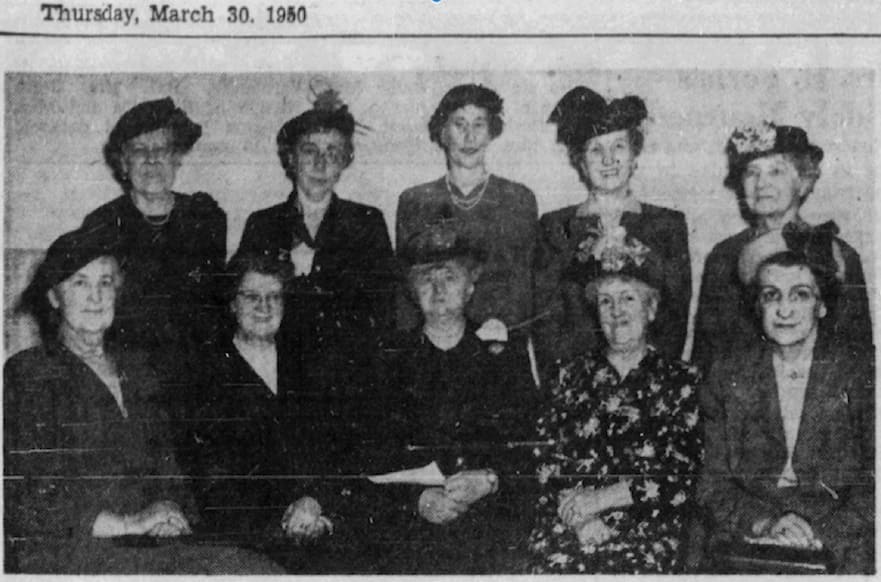 In March 1950, the Ottawa Citizen covered the appointment of the directors of the Women’s Canadian Historical Society of Ottawa, which would soon admit male members and rename itself the Historical Society of Ottawa. She added: “With Words as Their Actions pays tribute to the women who kept Bytown alive long after its transformation into Ottawa . . . Here were these women who were saying, ‘We are going to start losing history if we don’t start saving it.’ ”
In March 1950, the Ottawa Citizen covered the appointment of the directors of the Women’s Canadian Historical Society of Ottawa, which would soon admit male members and rename itself the Historical Society of Ottawa. She added: “With Words as Their Actions pays tribute to the women who kept Bytown alive long after its transformation into Ottawa . . . Here were these women who were saying, ‘We are going to start losing history if we don’t start saving it.’ ”
The installation was created by the Toronto-based firm PLANT Architect Inc., which was awarded the commission after a public art competition held in 2015. The company previously created the Canadian Firefighters Memorial on LeBreton Flats.
As part of the contract for construction of the LRT system, one per cent of the overall construction cost was set aside for displays of artwork at each of the 13 light rail stations.
PLANT Architect’s tribute to the founders of the WCHSO and their work as preservers and promoters of the city’s history cost $200,000.
The silhouetted figures are arrayed in pairs of women facing each other, “representing the society’s founders gathered in conversation” and “passing their knowledge from one another, and to the viewer,” the creators explained.
“This historical society was Ottawa’s first, and from the late 19th century until after World War II, all of its members were female,” PLANT partner Lisa Rapoport, the project’s design lead, told the Daily Commercial News in an interview earlier this year. “While their husbands were building with wood, stone, rail ties and financial capital, the society’s members were building an edifice of words and stories.”
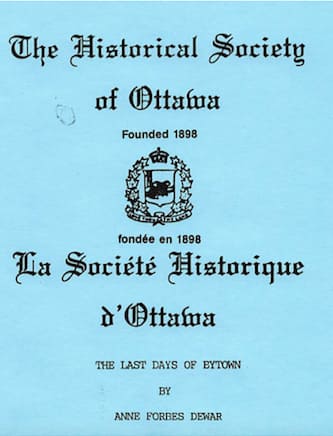 Society member Anne Forbes Dewar, top left, authored a 1954 paper titled “ The Last Days of Bytown ,” republished by the HSO in 1989. The entire 5,000-word text of the pamphlet — in English and French — has been incorporated in a steel sculpture installed at the Lyon LRT station that celebrates the role of the WCHSO in preserving and promoting Ottawa’s history.
Society member Anne Forbes Dewar, top left, authored a 1954 paper titled “ The Last Days of Bytown ,” republished by the HSO in 1989. The entire 5,000-word text of the pamphlet — in English and French — has been incorporated in a steel sculpture installed at the Lyon LRT station that celebrates the role of the WCHSO in preserving and promoting Ottawa’s history.
The design, states a PLANT over-view of the project, “celebrates women as keepers of history — and in particular, the 32 women who, in 1898, founded the Ottawa chapter of the Women’s Canadian Historical Society (now the Historical Society of Ottawa).”
The bulk of the sculpture is comprised of alternating English and French lines of text from a presentation titled “The Last Days of By-town,” written in 1954 by society member Anne Forbes Dewar and published in 1989 as No. 32 of the HSO’s Bytown Pamphlet series.
There are now more than 100 published papers in the Bytown Pamphlet series, most of which are available for download at the HSO website — including Dewar’s essay — and all of which are available through the Ottawa Public Library. In a brief introduction to the Dewar pamphlet, the author was described as “an early and active member” of the WCHSO, which she also served as a board member: “She loved history and was extremely knowledgeable and well-read, especially about local history.”
Dewar, who died in 1964, had prepared her 1954 research paper by poring over old Ottawa newspapers, consulting local history books and tapping a variety of other sources to paint a portrait of Bytown as it exist- ed 100 years earlier, in 1854 — the year before the city was officially renamed Ottawa on Jan. 1, 1855.
“This is an amazing document,” Rapoport said in the DCN interview, referring to Dewar’s painstaking reconstruction of 1854 Bytown, on the eve the change to the City of Ottawa. “We thought it would be great for everybody to read it.”
Among the most noteworthy passages in Dewar’s pamphlet — especially now that her words have been laser-cut in steel into a permanent artwork at a downtown train station — were her observations about the December 1854 inauguration of the Bytown and Prescott Railway.
It was a landmark event in Ottawa history and marks the birth of rail transportation in the city.
In recounting the arrival in By-town of the first-ever trainload of passengers from Prescott on Christmas Day 1854, Dewar commented that a celebratory banquet following the event “provided the appropriate jollification.”
She then offered further thoughts on the railway’s launch that should offer some solace to present-day city officials who have faced sharp criticism over the LRT’s bumpy rollout throughout the fall and early winter of 2019.
“The railway had been a great accomplishment,” Dewar wrote of the launch of train service in 1854. “As might have been expected in the early days of operation, unlooked for difficulties arose . . . (but) before long the Bytown and Prescott was generally acknowledged to be the safest and smoothest railway line on the American continent.”
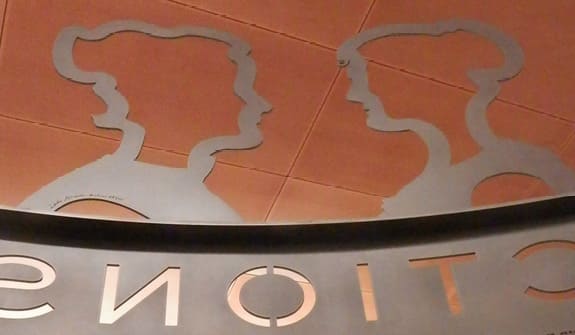 The silhouettes of Lady Matilda Ridout Elgar, host of the inaugural meeting of the WCHSO, and found- ing member Gertrude Kenny appear to engage in conversation atop the massive art installation at the Lyon Street LRT station.
The silhouettes of Lady Matilda Ridout Elgar, host of the inaugural meeting of the WCHSO, and found- ing member Gertrude Kenny appear to engage in conversation atop the massive art installation at the Lyon Street LRT station.
Photo: Randy BoswellSeveral HSO members, including past president George Neville and former board members Don Baxter and Bryan Cook, were consulted during the design of the Lyon Station artwork.
The impressive LRT tribute to the matriarchs of the present Historical Society of Ottawa joins a host of other landmarks around the capital attesting to the HSO’s enduring impact since its founding near the end of the 19th century.
These include the Bytown Museum beside the Rideau Canal head-locks and the statue of Lt.-Col. John By in Major’s Hill Park, both of which were society initiatives.
“No longer will only society members be familiar with our beginnings as the WCHSO,” said Karen Lynn Ouellette, president of the Historical Society of Ottawa. “This stunning artistic installation invites all LRT travellers to learn about our society’s contributions to saving and sharing our local heritage.”
She added: “I am so proud to be part of this legacy of women helping to preserve our city’s history.”
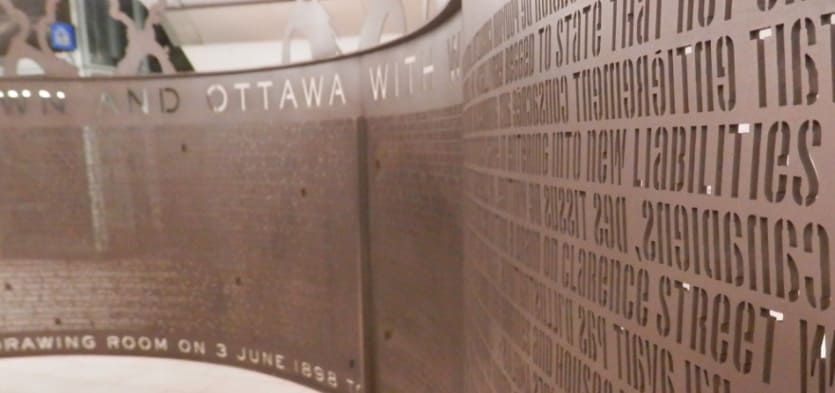 The curving, curtain-like sculpture (below), a tribute to the female founders of the historical society, invites passersby to sample bits of early Ottawa history inscribed in steel.
The curving, curtain-like sculpture (below), a tribute to the female founders of the historical society, invites passersby to sample bits of early Ottawa history inscribed in steel.
Photo Randy Boswell




